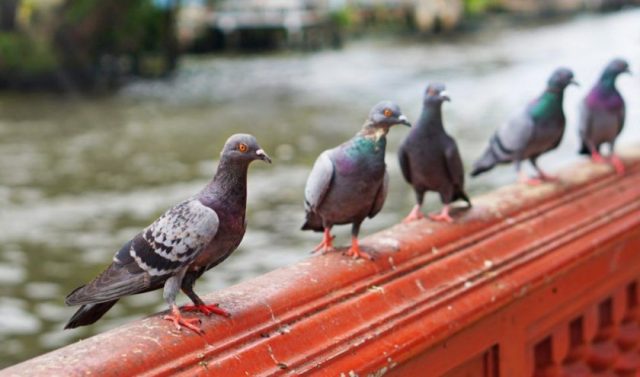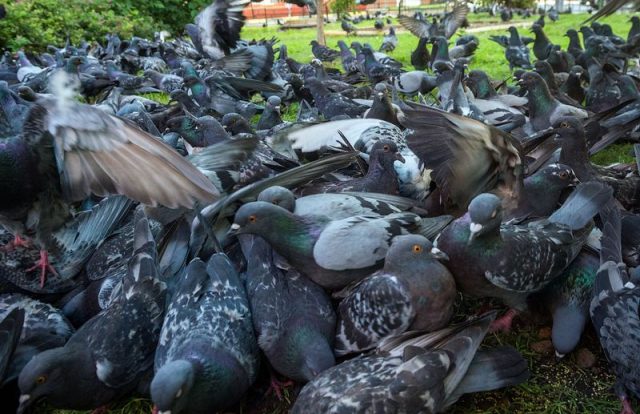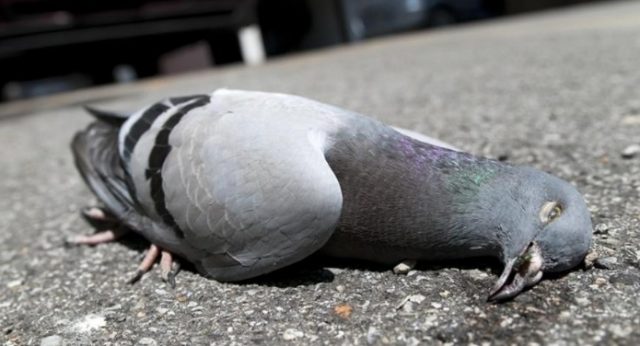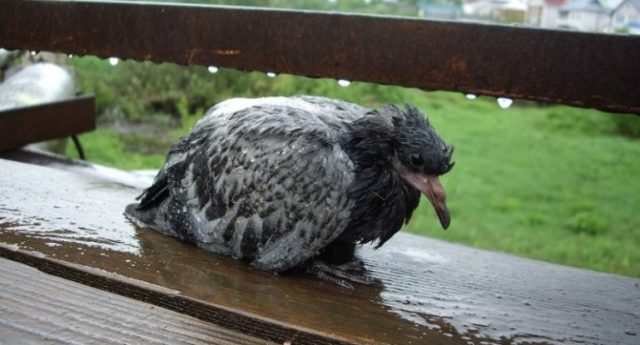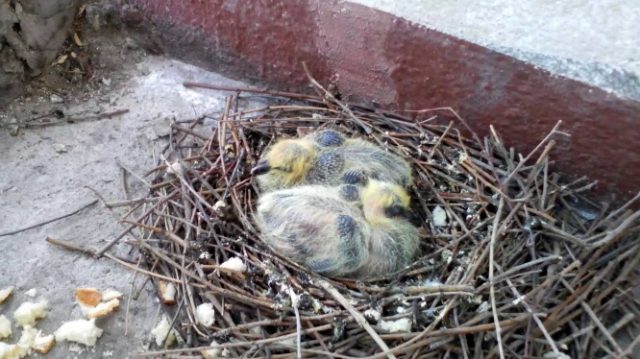Content
The opinion of doves as symbols of peace arose from the ancient Greek myth of a dove who made a nest in the helmet of the god of war Mars. In fact, pigeons are not peaceful birds and often kill their weak relatives. But the pigeons are not limited to cannibalism. Pigeons - carriers of diseases for humans, are able to work as a biological weapon in the area, which birds are antipodes according to myth.
Is it possible to catch the disease from pigeons
Even without direct contact with a pigeon, a person has not zero chances of contracting an anthropozoonotic, that is, a disease common to animals and humans. Many diseases in pigeons are transmitted through faecal contaminated water, food or surfaces. City pigeons defecate while sitting on a balcony railing. It is enough not to wash your hands after touching the railing to get infected with one of the pigeons' diseases dangerous for humans. In birds, these diseases are not treated. Antibiotics can help people. But some of the diseases carried by pigeons are difficult to cure. Such diseases of pigeons have time to leave irreparable damage in the human body.
How does the infection take place
Many infectious diseases in pigeons are transmitted in the "traditional" way. That is, pigeon droppings contaminate water and food. In summer, pigeons trample on the windowsill, starting fights and raising dust. The windows are usually open for ventilation. Dust and droppings raised by pigeons fly into the apartment and fall into open containers with food. In this way, a person is infected through the gastrointestinal tract.
One of the most dangerous to humans, the disease of pigeons, which causes a cough similar to the common cold, is transmitted by air. This is psittacosis. It is often called "parrot disease", as it can be infected not only from pigeons, but also from domestic ornamental birds.
Another way of infection with diseases of pigeons is blood-sucking parasites. Ixodid ticks, "glorious" for their ability to transmit encephalitis, also parasitize pigeons. In addition to tick-borne encephalitis, ticks can be carriers of other diseases of pigeons. Pigeon bugs can also carry disease in pigeons. The difference between the parasites is that the tick can at any time fall off the pigeon and fall on the floor of the balcony or apartment, and the bugs live in pigeon nests.
What diseases do pigeons carry for humans
Most diseases transmitted to humans from pigeons are caused not by viruses, but by bacteria and protozoa. But since the causative agents of diseases of pigeons are specific, one person gets sick. Diseases of pigeons are not able to be transmitted from person to person. An exception is psittacosis, which can spread to the whole family. Usually the source of infection in a "mass" disease is a recently purchased parrot. If no one brought home a sick pigeon.
It is very easy to bring a sick pigeon home. Fledgling pigeons cannot fly fully. People catch little pigeons out of pity. In the best case, they are planted higher, but the contact has already been made. At worst, they bring pigeons home. You can meet an adult flightless pigeon. Many people think that the pigeon was damaged by a cat, and they try to cure the bird at home.But the flightless adult pigeon is sick. And the third option is a nest of pigeons on the balcony: diseases carried by pigeons are hidden in birds and are “activated” in the human body. The nest of pigeons on the balcony is not a joy and not "a good omen: soon someone will marry / get married", but a potential source of diseases that pigeons carry:
- psittacosis;
- salmonellosis;
- campylobacteriosis;
- listeriosis;
- tularemia;
- cryptococcosis;
- toxoplasmosis;
- Newcastle disease.
Against the background of these diseases, such a "trifle" as an allergy to feather scales falling from pigeons can be ignored. Not everyone is allergic to pigeons.
Ornithosis
Less known than leptospirosis, an acute infectious disease of birds. Chlamydia is a disease of the species Chlamydia psittaci. In pigeons, psittacosis is often asymptomatic, but sometimes it progresses to the clinical stage. The main symptom of the disease is the complete absence of fear of a person in a pigeon. The dove does not seek to avoid contact. The plumage of a pigeon is often disheveled, and serous-purulent outflows from the eyes are also present. It is impossible to feel sorry for such a pigeon and to contact him.
The causative agent of psittacosis remains in the external environment for up to 3 weeks. An outwardly healthy pigeon carries the disease, releasing chlamydia into the external environment along with the droppings. When it enters the human body, together with the dust, the bacterium penetrates into the cells, where it develops. The appearance of the first symptoms of the disease depends on the place where chlamydia has penetrated. Psittacosis affects:
- lungs;
- Central nervous system;
- liver;
- spleen.
In humans, the disease usually begins with damage to the respiratory system, since this is the main route of transmission of psittacosis from birds to humans.
Psittacosis in humans is quite difficult and can cause serious complications. There are two forms of the disease: acute and chronic. Acute is the most common form when infected by a pigeon or other bird. The incubation period lasts from 6 to 14 days. Begins as a lung infection:
- a sudden rise in temperature to 39 ° C;
- headache;
- runny nose;
- stuffy nose;
- general weakness;
- muscle pain;
- decreased appetite;
- sore throat and dryness.
After another couple of days, a dry cough develops, chest pain appears, aggravated by inhalation. Later, a dry cough turns into a wet cough with sputum production.
If the signs of psittacosis were taken for the manifestation of more common respiratory diseases: pneumonia, bronchitis, acute respiratory infections, acute respiratory viral infections, the treatment will be incorrectly prescribed, and chlamydia will have time to penetrate the bloodstream, causing damage to the internal organs and the central nervous system.
The chronic form of the disease is characterized by the defeat of the adrenal glands, central nervous system and edema of the liver and spleen. Since chlamydia poisons the body with waste products, the patient has constant intoxication with a consistently high temperature up to 38 ° C and signs of bronchitis. The chronic form can last more than 5 years.
The acute form can be typical with the development of pneumonia and atypical, in which meningitis, meningopneumonia and psittacosis develop without lung involvement. The disease is treatable, but it is a long and difficult process. Treatment with specific antibiotics is required for 2-3 months. Immunity after recovery does not last long and repeated cases of the disease are quite likely.
Complications
Dangerous psittacosis and the development of diseases leading to death: acute heart failure and thrombophlebitis. Hepatitis and myocarditis also develop. With secondary infections, purulent otitis media and neuritis are observed. In pregnant women, the fetus is aborted.
Salmonellosis
The most "famous" disease of birds, which is transmitted even through chicken eggs. It is also the main disease transmitted to humans by pigeons. The prevalence of salmonellosis is explained by the fact that chicks become infected even in the egg. In pigeons, salmonellosis often occurs without external signs. The sick female lays already infected eggs. Clinical signs of the disease appear if the pigeon weakens for one reason or another.
Salmonellosis is transmitted through droppings and direct contact with a sick pigeon. In humans, Salmonella is localized in the small intestine, causing gastrointestinal diseases.
The incubation period for salmonellosis can be from 6 hours to 3 days. Most often, the latent period lasts 12-24 hours. The course of the disease can be acute or latent. In the first case, the symptoms of the disease are well pronounced, in the second, a person may not even suspect about the infection, being a carrier of salmonella and infecting others.
After colonization of the small intestine, multiplying salmonella secrete a toxin that poisons the body. Signs of intoxication:
- loss of water through the intestinal wall;
- violation of the tone of the blood vessels;
- disruption of the central nervous system.
Outwardly, salmonellosis is expressed as a gastrointestinal disease. Salmonellosis is often confused with severe poisoning caused by spoiled foods:
- vomiting;
- nausea;
- high temperature;
- headache;
- general weakness;
- severe intestinal upset, resulting in loose, watery stools;
- abdominal pain.
Severe diarrhea makes the body dehydrated. As a result of exposure to toxins, the liver and spleen increase in size. Renal failure may develop.
With timely diagnosis and proper treatment, salmonellosis disappears in 10 days. For treatment, antibiotics of the penicillin group and fluoroquinolones are used.
Campylobacteriosis
One of the diseases that are asymptomatic in pigeons, but in humans they cause serious damage to almost all body systems.
The disease also belongs to intestinal infections. Campylobacter enters the human intestinal tract through food and water contaminated by pigeons. Young children who do not have strong immunity are especially affected. In children under 1 year of age, Campylobacter can cause sepsis.
Since children love to stick their fingers in their mouths, it is enough for a child to touch the railings contaminated with pigeons to become infected with campylobacteriosis. The disease is very variable in its manifestations and it is easy to confuse it with other diseases.
Disease development
The incubation period lasts 1-2 days. After that, signs of flu appear, which deceive most parents:
- headache;
- fever;
- myalgia;
- malaise;
- temperature rise up to 38 ° С.
This condition lasts for 24-48 hours. This period is called prodromal, that is, immediately preceding the disease.
After the prodromal period, symptoms of a real disease related to intestinal infections appear:
- nausea;
- vomiting;
- severe abdominal pain;
- severe diarrhea, stool becomes foamy, runny, and offensive;
- possible dehydration with diarrhea.
2 days after the onset of symptoms of this disease, signs of colitis appear. The pain in the abdomen becomes cramping, often mimicking the picture of appendicitis with symptoms of peritonitis.
Treatment of the intestinal form of the disease is carried out with erythromycin and fluoroquinolones. Extraintestinal - tetracycline or gentamicin. The prognosis for the disease is usually good, but death is possible in young children and people with immunodeficiency.
Listeriosis
It is more difficult to contract listeriosis from pigeons than other diseases, but nothing is impossible. Listeria monocytogenes is interesting because its natural primary reservoir is soil. From there, it enters the plants.And only then "gets over" into herbivores. A person most often becomes infected with listeriosis by eating contaminated food and water.
There are no obvious ways of infection with listeriosis from a pigeon, but again you need to remember the problem of unwashed hands. The most favorable breeding environment for Listeria is the top layer of the silage. This is how the bacteria infect livestock and pigeons.
At first glance, listeriosis has nothing to do with city pigeons. But there are city dumps with rotting food waste that are excellent substitutes for silage. The dove is an almost omnivorous bird. After walking through the waste, the pigeon infects itself and becomes a mechanical carrier of bacteria. Pigeons can fly over long distances. After eating at the landfill, the pigeons return to the roofs, balconies and window sills of houses, becoming carriers of the disease. Transmission of listeriosis to humans here becomes a matter of technology.
The disease in pigeons usually has a latent course. Listeriosis is openly manifested in weakened pigeons. Since Listeria affects the nervous system, clear clinical signs mean that the pigeon is already dying. In this case, listeriosis can already be transmitted directly from the pigeon to humans by contact.
Listeria usually enters the human body through the gastrointestinal tract. The disease begins as an intestinal infection. Further development of symptoms depends on the location of the listeria colony.
Symptoms of listeriosis
Risk groups for listeriosis:
- children under one year old;
- pregnant women;
- adults over 55;
- people with diabetes, cancer or HIV;
- undergoing corticosteroid treatment.
Listeria infection of the central nervous system can lead to meningitis and encephalitis. Fatalities have also been reported in cases of listeriosis.
The incubation period lasts from several days to several weeks. Sometimes it can last for several months. During this time, a person manages to forget about contact with pigeons and is unaware of infection. Due to the wide variability of symptoms, an accurate diagnosis is made in the laboratory and no earlier than 2 weeks from the date of sampling. You need to start treatment as early as possible. In total, there are 10-18 forms of the disease.
Sharp:
- chills;
- headache;
- muscle and joint pain;
- after 3 weeks, an increase in the liver, spleen and lymph nodes;
- the appearance of a red rash on the body with the formation of a "butterfly" on the face and thickening of papules in the joints;
Visceral:
- fever;
- enlargement and soreness of the lymph nodes;
- constipation;
- catarrhal sore throat;
- enlargement of the spleen and liver;
Glandular;
- excessive sweating;
- chills;
- fever;
- enlarged lymph nodes, spleen and liver;
- sometimes cervical lymphadenitis and tonsillitis;
- very rarely eye damage;
Nervous:
- headache;
- chills;
- fever;
- violation of skin sensitivity;
- convulsions;
- rave;
- violation of consciousness;
- mental disorders;
- drooping of the eyelids;
- different sizes of pupils;
Mixed:
- joint and muscle pain;
- fever;
- headache;
- enlarged spleen, liver and lymph nodes;
- angina;
- fuzzy neurological signs are present;
Chronic: asymptomatic; sometimes manifests itself as a flu; dangerous for pregnant women, as the fetus can become infected.
With listeriosis in pregnant women, there is no clear picture of symptoms. Only shortly before childbirth, the disease can manifest itself with chills, fever and muscle pain. Sometimes angina and purulent conjunctivitis develop. Abortion is recommended.
In newborns, listeriosis is severe. With intrauterine infection, the baby is born dead or premature. In the latter case, the death of the child occurs within 2 weeks. When infected during childbirth, the disease manifests itself after 7-14 days:
- dyspnea;
- fever;
- stuffy nose;
- lethargy;
- lethargy;
- bluish skin;
- rash on hands and feet;
- enlargement of the liver;
- possible development of jaundice;
- sometimes convulsions and paralysis develop.
Listeriosis responds better to early treatment, which is usually overlooked. Antibiotics of the penicillin and tetracycline groups are prescribed. The treatment lasts 2-3 weeks.
Tularemia
A disease of pigeons, which a person can become infected without contact with a pigeon. It is enough for the pigeons to build a nest on the balcony. Francisella tularensis bacteria are transmitted:
- contact with animals;
- through contaminated food and water;
- by air by inhalation of dust from cereals;
- blood-sucking parasites.
The natural reservoir for bacteria is small wild animals. Pigeon bugs are looking for a new source of food in case of loss of the owner. If the pigeon was sick, the parasite crawling into the house from the nest can transmit the disease to people.
Tularemia is widespread in Russia. It is not worth counting on a favorable epidemiological situation in the region. Suffice it to recall the "accusation" of the USSR in the use of tularemia near Moscow as a bacteriological weapon during the Second World War. But no one used anything, sick mice came to bask in a person's dwelling. At that moment, the Germans were in the houses.
The incubation period usually lasts 3-7 days. Duration up to 21 days or the appearance of the first signs only a few hours after infection are possible. There are several forms of the course of the disease:
- bubonic: skin penetration;
- conjunctival-bubonic: damage to the mucous membrane of the eye;
- ulcerative bubonic: ulcer at the site of infection;
- angina-bubonic: damage to the mucous tonsils with oral infection;
- broncho-pneumonic with bronchitic and pneumonic variants of the course;
- abdominal (intestinal): occurs in winter and autumn;
- generalized (primary-septic): proceeds with signs of general intoxication of the body.
The disease begins with a rise in temperature to 40 ° C. The temperature rises suddenly, without any preliminary signs. Further appear:
- dizziness;
- Strong headache;
- loss of appetite;
- muscle pain in the legs, back and lower back;
- in severe cases, nosebleeds and vomiting are added.
Sweating, insomnia, or drowsiness are common with tularemia. Against the background of a high temperature, increased activity and euphoria may occur. In the first days of the disease, swelling and redness of the face are noted, conjunctivitis develops. Later, hemorrhages appear on the oral mucosa. Tongue with a gray coating.
Depending on the form of the disease, there may be other signs characteristic of a particular type of disease course.
Tularemia is treated with antibiotics for 2 weeks. Relapses or specific complications of the disease are possible.
Pseudotuberculosis
Second name: Far Eastern scarlet fever. Mammals and birds are ill with pseudotuberculosis. The disease is poorly understood. The main route of infection is contaminated food. The likelihood of getting the pathogen Yersinia pseudotuberculosis from a pigeon into human food is small, but it should not be ruled out.
Pseudotuberculosis sick pigeons are immediately noticeable. Pigeons are depressed, with disheveled plumage. The breathing of the pigeon is difficult, the position of the head is abnormal.
Treatment for pseudotuberculosis in pigeons has not been developed. Sick pigeons are immediately destroyed. Owners of expensive pigeons try to treat sick birds on their own with the help of antibiotics, endangering not only themselves, but also those around them.
Symptoms of pseudotuberculosis in humans
In humans, pseudotuberculosis occurs as an acute intestinal infection. The most common localized form, which occurs in 80% of cases of this disease:
- temperature up to 39 ° C;
- headache;
- vomiting;
- chills;
- stomach ache;
- myalgia;
- weakness;
- diarrhea up to 12 times a day;
- fetid, frothy, brownish-green stool. If the colon is involved, the feces may contain mucus and blood.
Possible joint damage, rash, and signs of hepatitis.
With the arthralgic form of the course, rheumatism is often erroneously diagnosed. With this form of the disease, diarrhea and vomiting may not be present, but there is pain in the joints, damage to the gastrointestinal tract and a rash.
The generalized form begins with a temperature of 38-40 ° C, weakness and vomiting. Next, conjunctivitis develops, the liver and spleen enlarge. After 2-3 weeks, a rash appears on the limbs. From the 4th week, self-healing begins, with exfoliation of the skin at the site of the rash.
The septic form of the disease develops in people with immunodeficiency: temperature up to 40 ° C, chills, sweating, anemia. This form of the disease lasts from several months to a year. Deaths reach 80%.
Pseudotuberculosis is treated with antibiotics. Patients are prescribed a special diet.
Tuberculosis
The chances of contracting tuberculosis from a pigeon are much higher than getting scarlet fever. In pigeons, tuberculosis occurs in a chronic form with blurred symptoms. The main symptoms in the form of a decrease in egg production and exhaustion in pigeons are not monitored by anyone. The presence of tuberculosis in a pigeon can be suspected by lameness and a tumor-like formation on the sole of the paw. Tuberculosis is not treated in any species of domestic animals, since this disease is included in the list of dangerous ones.
In any big city, there is a place for a pigeon to contract tuberculosis. Then the pigeon can pass it on to the person. Symptoms of TB in humans:
- prolonged cough with phlegm;
- low-grade fever for a long time;
- weakness;
- decreased appetite;
- night sweats;
- weight loss.
In humans, tuberculosis manifests itself with a general weakening of the immune system, but when faced with an active Koch's bacillus, even a person without health problems can get sick.
Treatment of tuberculosis requires a long time and an integrated approach. It is better to conduct it in a hospital under the supervision of a doctor.
Cryptococcosis
Pigeons cannot tolerate cryptococcosis. But the disease is caused by the yeast Cryptococcus neoformans. These fungi grow on bird droppings. They are usually isolated from pigeon droppings and nests. Fungi may be present in soil contaminated or fertilized with droppings. Cryptococci are also isolated from mammalian droppings. The disease is not transmitted from person to person. The transmission path is dust in the air.
The disease develops in people with lowered immunity. This is typical for any mold and yeast. People with HIV are most susceptible to illness. Cryptococcosis can take 3 forms:
Pulmonary: asymptomatic or with fever, hemoptysis and cough with phlegm;
Disseminated, which is usually recorded in patients with immunodeficiency. They are amazed:
- kidneys;
- adrenal glands;
- eyes;
- heart;
- prostate;
- bones;
- lymph nodes;
- painless skin lesions may occur;
Cryptococcal meningitis:
- asymptomatic in the initial stage;
- dizziness;
- fever;
- headache;
- epileptic seizures;
- visual impairment.
The pulmonary form is observed in 30% of those infected with cryptococcosis. Treatment with intravenous injections of antifungal drugs lasts 1.5-2.5 months.
But the lack of treatment will be fatal.
Toxoplasmosis
The disease is caused by a single-celled parasite. Both mammals and birds are sick. The pathways of infection in the wild are poorly understood. It is believed that pigeons become infected with parasites by eating contaminated food.
A person can be infected directly from a pigeon.The disease in pigeons proceeds with obvious clinical signs and few people dare to take a sick pigeon in their hands. During the acute period of the disease, the pigeon walks in circles, it has convulsions, a wobbly gait and refusal to feed. Only 50% of pigeons survive the acute stage. In surviving pigeons, toxoplasmosis passes into a chronic stage with periodic release of pathogens into the external environment through droppings.
A chronically ill pigeon carries the disease on its own and can serve as a food source for other vectors: blood-sucking parasites. Ticks and bedbugs also carry Toxoplasma.
In humans, toxoplasmosis can be congenital or acquired. In adults, the acquired disease is usually so mild that it is not even suspected. But sometimes toxoplasmosis becomes acute or chronic.
An acute course can be;
- typhoid-like: high fever, enlarged liver and spleen;
- with damage to the central nervous system: headache, vomiting, convulsions, paralysis.
More often, a chronic form is observed with a slightly elevated temperature, headache and enlargement of the liver and lymph nodes. This form can also be accompanied by damage to other internal organs, eyes and central nervous system.
The disease is especially dangerous for pregnant women and newborn babies. A child can get a congenital form if the mother is infected. Very often the fetus or newborn dies. Survivors have lesions of the central nervous system, various organs and severe oligophrenia.
Treatment of the disease is required for people with reduced immunity. Apply a course of antibacterial drugs.
Newcastle disease
The only one of all diseases of pigeons transmitted to humans, the causative agent of which is a virus. Almost all birds are sick, but pheasants are most susceptible. A pigeon can transmit Newcastle disease to humans through close contact. The virus causes mild conjunctivitis and flu-like symptoms in humans. This disease of pigeons does not pose a danger to human health.
Preventive actions
Prevention of diseases carried by pigeons is to reduce contact with these birds and their waste products. Ideally, do not contact them at all:
- do not feed;
- do not pick up pigeons on the street;
- do not allow pigeons to build a nest on the balcony;
- ward off pigeons from window sills and balcony railings;
- maintain personal hygiene and wash your hands more often.
It is advisable to conduct a preventive conversation with neighbors who feed pigeons.
Conclusion
Pigeons that have bred in the city - carriers of diseases for humans, can cause significant problems to the population. It is necessary not only to control the number of pigeons by the city authorities. Residents also need to take care of their children. Do not feed pigeons. Reducing the food supply automatically reduces the number of pigeons without human effort.


